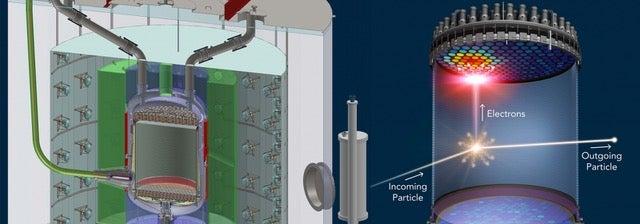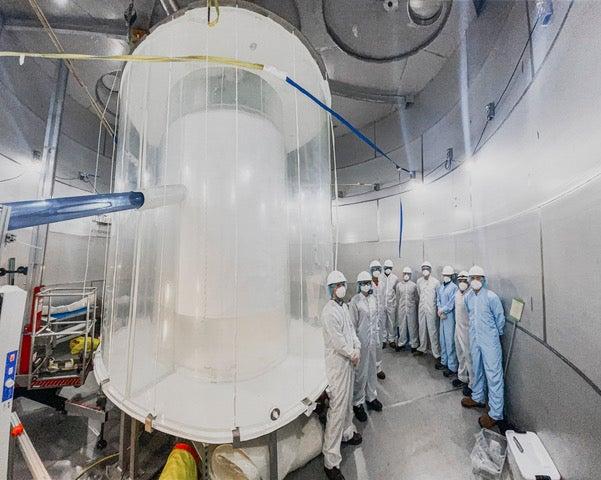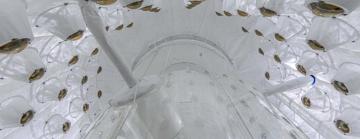Researchers mark successful startup of LUX-ZEPLIN dark matter detector at Sanford Underground Research Facility
SLAC researchers contributed to the design, construction, testing and analysis of the experiment, which has already put the tightest bounds yet on a popular theory of dark matter.
Deep below the Black Hills of South Dakota in the Sanford Underground Research Facility (SURF), an innovative and uniquely sensitive dark matter detector – the LUX-ZEPLIN (LZ) experiment, led by the U.S. Department of Energy's (DOE) Lawrence Berkeley National Lab (Berkeley Lab) – has passed a check-out phase of startup operations and delivered first results.
The take home message from this successful startup: “We’re ready and everything’s looking good,” said Berkeley Lab Senior Physicist and past LZ spokesperson Kevin Lesko. “It’s a complex detector with many parts to it, and they are all functioning well within expectations,” he said.
In a paper posted online today, LZ researchers report that with the initial run, LZ is already the world’s most sensitive dark matter detector. The paper will appear on the online preprint archive arXiv.org later today. LZ spokesperson Hugh Lippincott of the University of California, Santa Barbara, said, “We plan to collect about 20 times more data in the coming years, so we’re only getting started. There’s a lot of science to do and it’s very exciting.”
Maria Elena Monzani, a lead scientist at SLAC and LZ deputy operations manager for computing and software, said that SLAC has made a number of key contributions to the project, procuring and purifying the liquid xenon that fills the detector's central cavity, and building and testing electrode sensor grids. SLAC researchers also built and operated a test platform for detector components and organized mock data challenges to help researchers understand how to sift through the data for signs of dark matter. The LZ effort at SLAC is led by Monzani together with SLAC professors Daniel Akerib and Thomas Shutt, who was the founding spokesperson of the LZ collaboration.
Alden Fan, a project scientist at DOE's SLAC National Accelerator Laboratory and a lead author on the new paper, said, "Since then, we have collected enough data to place the most stringent constraint to date on one of the most promising dark matter candidates," known as weakly interacting massive particles, or WIMPs. "The first major analysis from an experiment like this is always challenging and exciting, and the team rose to the challenge, with over 60 students and postdocs from around the world that directly contributed to the analysis. It's a result we can be proud of."

Unseen particles
Dark matter particles have never actually been detected, but LZ hopes to change that. Its first 60 "live days" of data were collected over a three-and-a-half-month span of initial operations beginning at the end of December. This was a period long enough to confirm that all aspects of the detector were functioning well.
Unseen, because it does not emit, absorb, or scatter light, dark matter’s presence and gravitational pull are nonetheless fundamental to our understanding of the universe. For example, the presence of dark matter, estimated to be about 85 percent of the total mass of the universe, shapes the form and movement of galaxies, and it is invoked by researchers to explain what is known about the large-scale structure and expansion of the universe.
The heart of the LZ dark matter detector comprises two nested titanium tanks filled with ten metric tons of very pure liquid xenon and viewed by two arrays of photomultiplier tubes (PMTs) able to detect faint sources of light. The titanium tanks reside in a larger detector system to catch particles that might mimic a dark matter signal.
The design, manufacturing, and installation phases of the LZ detector were led by Berkeley Lab Project Director Gil Gilchriese in conjunction with an international team of 250 scientists and engineers from over 35 institutions from the U.S., UK, Portugal and South Korea. The LZ Operations Manager is Berkeley Lab’s Simon Fiorucci. Together, the collaboration is hoping to use the instrument to record the first direct evidence of dark matter, the so-called missing mass of the cosmos.
Fiorucci said the onsite team at SURF deserves special praise at this startup milestone, given that the detector was transported underground late in 2019, just before the onset of the COVID-19 pandemic. He said with travel severely restricted, only a few LZ scientists could make the trip to help on site, and the team in South Dakota took excellent care of LZ.
Tomasz Biesiadzinski, a project scientist at SLAC and LZ detector operations manager, said, "I'd like to second the praise for the team at SURF and would also like to express gratitude to the large number of people who provided remote support throughout the construction, commissioning and operations of LZ, many of whom worked full time from their home institutions making sure the experiment would be a success and continue to do so now.”

An underground detector
Tucked away about a mile underground at SURF in Lead, South Dakota, LZ is designed to capture dark matter in the form of weakly interacting massive particles (WIMPs). The experiment is underground to protect it from cosmic radiation at the surface that could drown out dark matter signals.
The collisions will also knock electrons off xenon atoms, sending them to drift to the top of the chamber under an applied electric field where they produce another flash, which helps researchers reconstruct where in the tank collisions happened. The characteristics of the signal also help determine the types of particles interacting in the xenon.
Particle collisions in the xenon produce visible flashes of light, which are recorded by the PMTs, explained Berkeley Lab's Aaron Manalaysay who, as physics coordinator, led the collaboration’s efforts to produce these first physics results. “The collaboration worked well together to calibrate and to understand the detector response,” Manalaysay said. “Considering we just turned it on a few months ago and during COVID restrictions, it is impressive we have such significant results already.”
The take home message from this successful startup: “We’re ready and everything’s looking good,” said Berkeley Lab senior physicist and past LZ spokesperson Kevin Lesko. “It’s a complex detector with many parts to it and they are all functioning well within expectations,” he said.
Mike Headley, executive director of SURF, said, “The entire SURF team congratulates the LZ collaboration in reaching this major milestone. The LZ team has been a wonderful partner and we’re proud to host them at SURF.”
Monzani said, “We had amazing scientists and software developers throughout the collaboration, who tirelessly supported data movement, data processing, and simulations, allowing for a flawless commissioning of the detector. The support of NERSC [National Energy Research Scientific Computing Center] was invaluable.”
The South Dakota Science and Technology Authority, which manages SURF through a cooperative agreement with the U.S. Department of Energy, secured 80% of the xenon in LZ. Funding came from the South Dakota Governor's office, the South Dakota Community Foundation, the South Dakota State University Foundation, and the University of South Dakota Foundation.
LZ is supported by the U.S. Department of Energy, Office of Science and the National Energy Research Scientific Computing Center, a DOE Office of Science user facility. LZ is also supported by the U.S. National Science Foundation, the Science & Technology Facilities Council of the United Kingdom, the Portuguese Foundation for Science and Technology, and the Institute for Basic Science, Korea. Over 35 institutions of higher education and advanced research provided support to LZ. The LZ collaboration acknowledges the assistance of the Sanford Underground Research Facility.
Editor's note: This article is based on a press release from Lawrence Berkeley National Laboratory.
For questions or comments, contact the SLAC Office of Communications at communications@slac.stanford.edu.
SLAC is a vibrant multiprogram laboratory that explores how the universe works at the biggest, smallest and fastest scales and invents powerful tools used by scientists around the globe. With research spanning particle physics, astrophysics and cosmology, materials, chemistry, bio- and energy sciences and scientific computing, we help solve real-world problems and advance the interests of the nation.
SLAC is operated by Stanford University for the U.S. Department of Energy’s Office of Science. The Office of Science is the single largest supporter of basic research in the physical sciences in the United States and is working to address some of the most pressing challenges of our time.






